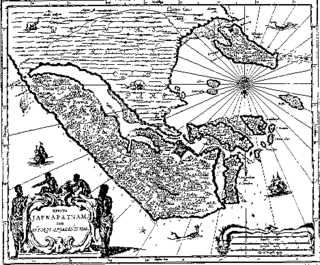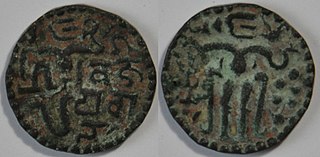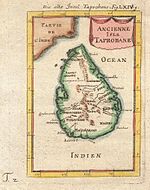
The Jaffna Kingdom, also known as Kingdom of Aryachakravarti, was a historical kingdom of what today is northern Sri Lanka. It came into existence around the town of Jaffna on the Jaffna peninsula and was traditionally thought to have been established after the invasion of Kalinga Magha from Kalinga in India. Established as a powerful force in the north, northeast and west of the island, it eventually became a tribute-paying feudatory of the Pandyan Empire in modern South India in 1258, gaining independence when the last Pandyan ruler of Madurai was defeated and expelled in 1323 by Malik Kafur, the army general of the Delhi Sultanate. For a brief period in the early to mid-14th century it was an ascendant power in the island of Sri Lanka, to which all regional kingdoms accepted subordination. However, the kingdom was overpowered by the rival Kotte Kingdom around 1450 when it was invaded by Prince Sapumal under the orders of Parakramabahu VI.

The Ayra Chakravarti dynasty were kings of the Jaffna Kingdom in Sri Lanka. The earliest Sri Lankan sources, between 1277 and 1283, mention a military leader of this name as a minister in the services of the Pandyan Empire; he raided the western Sri Lankan coast and took the politically significant relic of the Buddha's tooth from the Sinhalese capital city of Yapahuwa. Political and military leaders of the same family name left a number of inscriptions in the modern-day Tamil Nadu state, with dates ranging from 1272 to 1305, during the late Pandyan Empire. According to contemporary native literature, such as Cekaracecekaramalai, the family also claimed lineage from the Tamil Brahmins of the prominent Hindu pilgrimage temple of Rameswaram in the modern Ramanathapuram District of India. They ruled the Jaffna kingdom from the 13th until the 17th century, when the last of the dynasty, Cankili II, was ousted by the Portuguese.

Chandrabhanu or Chandrabhanu Sridhamaraja was the King of Tambralinga Kingdom in present-day Thailand, Malaysia and Sumatra and the Jaffna Kingdom in northern Sri Lanka. A Javaka, he was known to have ruled from during the period of 1230 until 1262. He was also known for building a well-known Buddhist stupa in southern Thailand. He spent more than 30 years in his attempt to conquer Sri Lanka. He was eventually defeated by the forces of the Pandyan Dynasty from Tamil Nadu in 1262 and was killed by the brother of the south Indian Emperor Jatavarman Sundara Pandyan.
Alagakkonara, also known as Alakeshwara, were a prominent feudal family that provided powerful ministers and military rulers during the medieval period in Sri Lanka. Some historians claim that the family was of Tamil origin, possibly from Madurai or Kanchipuram in Tamil Nadu, India. The family arrived in Sri Lanka around the 13th century and naturalized themselves in Sri Lanka.

The Kingdom of Kandy was a monarchy on the island of Sri Lanka, located in the central and eastern portion of the island. It was founded in the late 15th century and endured until the early 19th century.
Vira Alakesvara, also known as Vijayabahu VI, was the last King of Gampola who ruled from 1397 to 1411. He was the last prominent member of the Alagakkonara family.

The Portuguese conquest of the Jaffna Kingdom occurred after Portuguese traders arrived at the rival Kotte Kingdom in the southwest of modern Sri Lanka in 1505. Many kings of Jaffna, such as Cankili I, initially confronted the Portuguese in their attempts at converting the locals to Roman Catholicism, but eventually made peace with them.

The current capital of Sri Lanka, since 1982, is Sri Jayawardenepura Kotte. Over the course of the island's history, the national capital has been in several locations other than Sri Jayawardenepura Kotte, the following is a list of cities which have historically served as the capital city of Sri Lanka and its predecessor states.

The Kingdom of Sitawaka was a kingdom located in south-central Sri Lanka. It emerged from the division of the Kingdom of Kotte following the Spoiling of Vijayabahu in 1521. Over the course of the next seventy years it came to dominate much of the island. Sitawaka also offered fierce resistance to the Portuguese, who had arrived on the island in 1505. Despite its military successes, Sitawaka remained unstable, having to contend with repeated uprisings in its restive Kandyan territories, as well as a wide-ranging and often devastating conflict with the Portuguese. Sitawaka disintegrated soon after the death of its last king Rajasimha I in 1593.
Parâkramabâhu VI was the first king of Kotte, ruling from 1410 until his death in 1467. He is the last great king in Sri Lanka who managed to unite the island under one flag. His rule is famous for the renaissance in Sinhalese literature, due to the patronage of the king himself. Classical literature as well as many rock inscriptions and royal grant letters have been found, rendering much information pertaining to this period.

The Kingdom of Dambadeniya was a medieval kingdom in what is present-day Sri Lanka. The kingdom's rulers reigned from 1220–1345.

The Kingdom of Kotte, named after its capital, Kotte, was a Sinhalese kingdom that flourished in Sri Lanka during the 15th century.
When to date the start of the history of the Jaffna kingdom is debated among historians.
Bhuvanaikabahu IV was the first King of Gampola who ruled from 1344/5 to 1353/4. He succeeded his father Vijayabahu V of Dambadeniya and became the King of Gampola. He was succeeded by his brother Parakkamabahu V.

Parakramabahu II, also known as Panditha Parakramabāhu, was the King of Dambadeniya in 13th century, whose reign lasted from 1234 to 1269. As a pioneer in literature, he was bestowed with the honorary title "Kalikala Sahitya Sarvagna Pandita". Parakramabahu's reign is notable for the creation of numerous Sinhalese literal works such as, Kausilumina, Pūjāvaliya, Pāli Vishuddḥi Mārgaya, Thūpavaṃsa and Sidhath Sangarāva. He launched a campaign against the Eastern Ganga invader Kalinga Magha, and successfully expelled him in 1255, unifying Sri Lanka under one rule. He succeeded his father Vijayabahu III as King of Dambadeniya, and was succeeded by his elder son, Vijayabahu IV, after his death.

Vijayabahu IV was King of Dambadeniya in the 13th century, who ruled from 1267/8 to 1270. He succeeded his father Parakkamabahu II as King of Dambadeniya and was succeeded by his brother Bhuvanaikabahu I after being murdered consequent to a conspiracy.

Bhuvanaikabahu I was King of Dambadeniya in the 13th century, who ruled from 1271 to 1283. He succeeded his brother Vijayabahu IV as King of Dambadeniya and an Interregnum of 19 years is thought to have occurred after his death. His nephew Parakkamabahu III ruled from Polonnaruwa, and was not formally considered as a King of Dambadeniya.
Vijayabahu V was the last King of Dambadeniya in the 14th century, who reigned from 1325/26 to 1344/45. He succeeded Bhuvanaikabahu III as King of Dambadeniya and was succeeded by Bhuvanaikabahu IV, King of Gampola.

Sinhalese–Portuguese conflicts refers to the series of armed engagements that took place from 1518 to 1658 in Sri Lanka between the native Sinhalese kingdoms and the Portuguese Empire. It spanned from the Transitional to the Kandyan periods of Sri Lankan history. A combination of political and military moves gained the Portuguese control over most of the island, but their invasion of the final independent kingdom was a disaster, leading to a stalemate in the wider war and a truce from 1621. In 1638 the war restarted when the Dutch East India Company intervened in the conflict, initially as an ally of the Sinhalese against the Portuguese, but later as an enemy of both sides. The war concluded in 1658, with the Dutch in control of about half the island, the Kingdom of Kandy the other half, and the Portuguese expelled.














